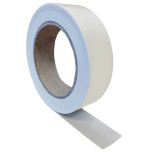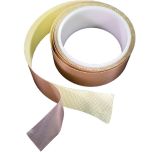Sealing Sailplane Gaps With Foam

Shawn here, with another brief informative article on sailplane sealing. Sealing can be simple to rather complicated. I am not going into detail about the proper way to seal your sailplane completely. Some pilots spend a significant amount of time on this task. Sean at Wings & Wheels (W&W) has excellent information concerning gap seals, mylars, videos, etc. I will defer to him. But we will look at some things I have developed or used over the years. Please remember always to ensure that no flight controls are binding or have any interference at all! Let’s go!
Gap Seal Tape
How long has your gap seal tape been sitting? Too long, it does not adhere? You do not need it! Using thin foam, you can seal your sailplane, wings, tailplane, and other gap openings. Run the foam along the wing profile joint, tailplane, spoiler box, and flight controls. See Fig. one @ two below. An excellent foam source is Amazon. This foam must be placed exactly along the profile edge so you do not “squish” it out when connecting your wings, etc. It may take a time or two to master, but it will be worth it. Foam works great! I recommend changing to new foam every annual or condition inspection. For those who de-rig every time you fly, maybe replace the foam every 3-6 months, as you may misalign the foam from the profile when installing, let's say, the wings, etc. On my DG-1000T, it remains together in the hangar unless I travel to a competition, etc.


Foam
Foam can be attached to the landing gear doors, engine compartment doors, and even between the ailerons/flap gaps and spoiler box edges. Again, please ensure that there is no control binding. The foam is so small that I think you would be fine, but check it.
“V” seal tape is a good choice for leaky or noisy canopies. W&W has it. (Editors note: See past article on installing V-Seal Tape HERE.) Foam can also be applied to the canopy if you desire horizontal stabilizer, wing roots, and winglets if you have them. Regarding canopy seals, be careful that the foam you installed will not deform the frame. Also, ALWAYS close and lock your canopy. It prevents frame deformation due to temperature ranges and an unexpected wind gust from a closely taxing towplane. Never leave a canopy unlocked! W&W has an excellent “V” seal for the canopy. I installed it on my DG 1000, which makes a massive difference in the quietness inside during flight, including high speed (120 kts +). I then removed my small line of foam.
So, using the foam method may save you some bucks and time on sealant tape. Did you know a pilot can spend as much as 30 minutes taping a sailplane? Sorry, Sean!
Water Drain Holes and Valves
Some like to cover or seal the water drain holes (if you have them) on the bottom of the wing with tape. Having the hole exposed has little effect on performance, if any. DO NOT! My opinion is that when you decide to load water, you will forget! Believe it or not, you cannot dump with that small piece of tape. Some sailplanes (Schempp-Hirth) and most have a drain valve under the wing; for leaking drain/dump valves, simply apply a small amount of toilet bowl sealer around the edges. I think it works very well. Some recommend vaseline. Just to remind you, it is imperative that you cycle your dump valves often. If they are not cycled, they will become frozen. Lube them with a little WD or LPS, etc. Just another quick note: On most sailplane dump valves, you have a small screw-type ball that may be used to install your tailplane, etc. This is also used to pull your dump valve tight after you add water. Do not pull too hard!
Add Fabric Softener
In closing, if you add a cup of Downy fabric softener to your wing during filling, you will prevent water spots from forming on the fuselage when and after dumping!
Banner photo by Sean Franke









